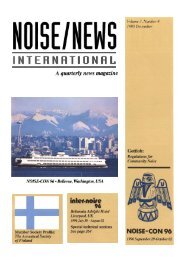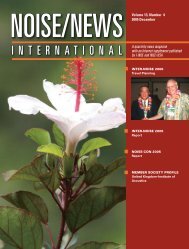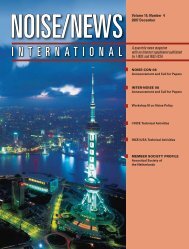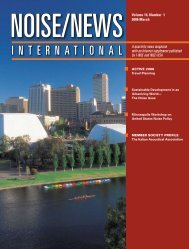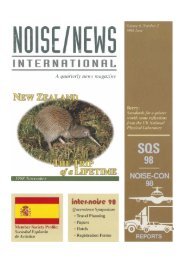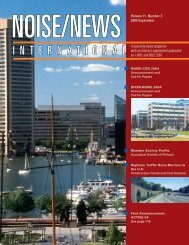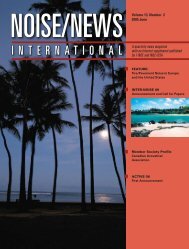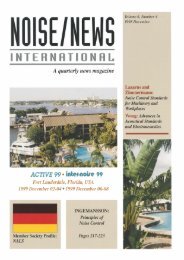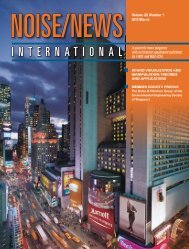Volume 4, Number 1, March, 1996 - Noise News International
Volume 4, Number 1, March, 1996 - Noise News International
Volume 4, Number 1, March, 1996 - Noise News International
- No tags were found...
You also want an ePaper? Increase the reach of your titles
YUMPU automatically turns print PDFs into web optimized ePapers that Google loves.
23,000 memberstoday, the IEEE Society on SignalProcessing is the fourth largest of the 37 semiautonomoussocietieswithinthe IEEE.The applicationof digital signal processing techniques to thefield of noisecontrolengineeringwhichhad spurredthe work of the G-AE in the late 1960s, as well asmostacousticalapplications, are subjectsof interestto the IEEE Society on Signal Processing today.TheAmerican Society ofMechanical Engineers(ASME) is an organization with 125,000members.ASMEhas 38divisionswhichareorganizedin eightgroups. The Management Division is the largestwith roughly a quarter of all ASME members. The<strong>Noise</strong> Control and Acoustics Division (NCAD) isone of the smallest with 695 members having primaryinterestin noiseand 693 with secondaryinterestin noise. Each division is headed by its ownchairman and executive committee, and has anumberof technicalcommitteeswhichcarry out thework of planning meeting programs and reviewingpapers.NCADwasestablishedin 1980,firstasanationalgroup,andthen as a full-fledgeddivision.The homefor its publications is the ASME Journal of Vibrationsand Acoustics. Its principalconferenceactivityis the ASME <strong>International</strong> MechanicalEngineeringCongressandExposition(IMECE), formerlyknownas the Winter Annual Meeting as it is held duringNovemberof the year,just before the Thanksgivingholiday.One mayjoin the ASMEwithminimalformality.In order to become a member, one needs to applyand obtain letters of recommendation, some ofwhich shouldbe from ASME members. A memberhas the opportunity to indicate an interest in threetechnical divisions (out of 38) when dues are paid.The member is then placed on the mailing lists forthese divisions. There are no other formalities foraffiliatingwith a particulardivision. Includedin theASME dues are subscriptions to the monthly MechanicalEngineering magazine and ASME <strong>News</strong>,plus subscriptions to the newsletters of the threedivisions selected by the member. <strong>News</strong>letters appeartwo to fourtimesa year and typicallyconsistofsix pages of division news items. The ASME publishesmore than a dozen archivaljournals, as wellas monographs and books, all at extra cost to themember. The ASMEorganizesmorethantwodozenmajor conferenceseach year.Withinthe ASME organization, NCADdoes nothave a unique charter in the fields of noise controland acoustics. The chartersof at least 20 of ASME's38 divisionsindicate some concern with noise controlin the broad sense. Severaldivisionshave longestablishedcommittees which are concerned withacoustics and vibration. The Applied MechanicsDivision, which is oriented towards theoreticalanalyses and dominatedby academics, has a shockand vibration committee. The Design EngineeringDivision, which has more of an applications orientationand more of an industrial membership, has avibration and sound committee. This committee isresponsible for the ASME Vibrations Conferences.<strong>Noise</strong> and vibration-related committees are to befound also in other ASMEdivisions: Fluid Dynamics,Gas Turbines, Gears, Safety, Manufacturing,and Piping and PressureVessels.The ASME procedure for reviewing papers andmanuscripts ensures thequality of thepapers presentedandpublished intheirjournals. Anindividualrespondingto a call for papers is usually requested to submit anabstract, on the basis of which a review committeejudgestheprobable suitability of thepaperfortheconferenceinquestion. Theauthor istheninvited tosubmita full manuscript which issubjected toreview bytwoorthree peers. Depending upon thereviewer's recommendations,anaccepted paper (revised asmayberequestedby thereview committee) maythenbe published eitherin an archival journal, or in theform of a preprint only,or in Mechanical Engineering. In mostcases, thefinalpreprinted version of thepapermustbeavailable beforethe paperis accepted for oralpresentation at a conference.The ASME publication process tends to be extendedanddrawn out; ittypically takes between 12and18 months from first offer to publication. Preprints ofindividual papers aresold atconferences; sets ofpapersarecollected intomonographs which aresoldin lieuofconference proceedings.The ASME clearly constitutes a natural "home"for mechanicalengineers- includingthosewithaninterestin noise controland related topics.Its meetingsprovide a mechanicalengineer with an opportunitytomeet other engineerswith relatedinterests.But the ASME paper-publication process is slow,and mostof the paperspresentedare of an academicnature. Controversial papers on "hot" topics mayfind their way into unpublished panel discussions,but rarely into print.The Society of Automotive Engineers (SAE)with a total membership of 66,000 covers automotiveengineering in its broadest sense; its scope includesaerospace engineering. The SAE does nothave a structure which parallels that of the ASME,its activities related to acoustics and noise controlbeing concentrated in two conferences. The <strong>International</strong>SAECongressheldannuallyinDetroitwithtens of thousands of participants usually has a fewpapers on noise and vibration control presented byoverseas authors who are attending the congress.The principal SAE activity of interest here is the<strong>Noise</strong> and Vibration Conferenceheld biannually inTraverseCity, Michigan.<strong>1996</strong> <strong>March</strong><strong>Noise</strong>/<strong>News</strong> <strong>International</strong> 11



